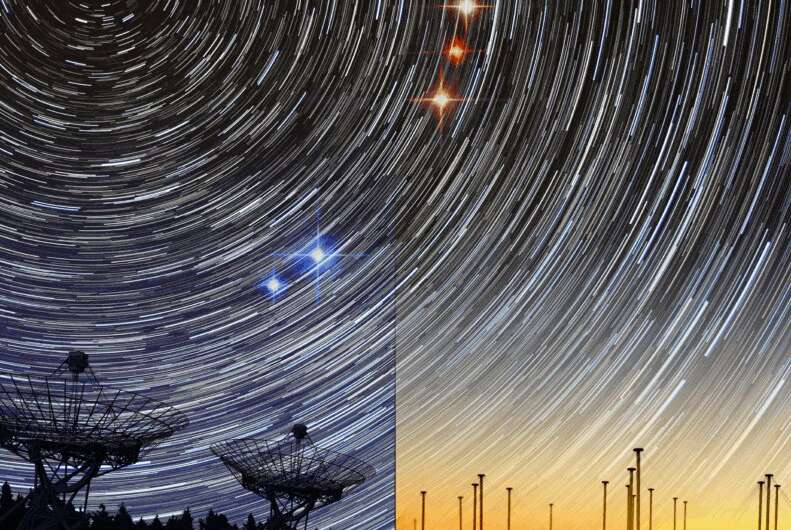the Westerbork dishes (left) detected a periodic, short fast radio burst in the blue, high-frequency radio sky. Time passed, the steady background stars turned into trails. Only much later did the same source emit in the red, low-frequency radio sky. The LOFAR telescope (right) now detected these for the first time. This chromatic behaviour shows the bursts are not periodically blocked by binary star winds. Credit: Joeri van Leeuwen
By connecting two of the biggest radio telescopes in the world, astronomers have discovered that a simple binary wind cannot cause the puzzling periodicity of a fast radio burst after all. The bursts may come from a highly magnetized, isolated neutron star. The radio detections also show that fast radio bursts, some of the most energetic events in the universe, are free from shrouding material. That transparency further increases their importance for cosmology. The results appear in Nature this week.
Radio colors
The use of "radio colors" led to the breakthrough. In optical light, colors are how the eye distinguishes each wavelength. Our rainbow goes from shorter-wavelength blue optical light, to longer-wavelength red optical light. But electro-magnetic radiation that the human eye cannot see, because the wavelength is too long or short, is equally real. Astronomers call this "ultra-violet light" or "radio light." The radio-light extends the rainbow beyond the red edge we see. The radio rainbow itself also goes from "bluer," short-wavelength radio to "redder" long-wavelength radio. Radio wavelengths are a million times longer than the wavelengths of optical blue and red, but fundamentally they are just "colors": radio colors.
The team of astronomers have now studied a fast radio burst at two radio wavelengths—one bluer, one much redder—at the same time. fast radio bursts are some of the brightest flashes in the radio sky, but they emit outside of our human vision. They only last about 1/1000th of a second. The energy required to form fast radio bursts must be exceedingly high. Still, their exact nature is unknown. Some fast radio bursts repeat, and in the case of FRB 20180916B, that repetition is periodic. This periodicity led to a series of models in which fast radio bursts come from a pair of stars orbiting each other. The binary orbit and stellar wind then create the periodicity. "Strong stellar winds from the companion of the fast radio burst source were expected to let most blue, short-wavelength radio light escape the system. But the redder long-wavelength radio should be blocked more, or even completely," says Inés Pastor-Marazuela (University of Amsterdam and ASTRON), the first author of the publication.
Combining Westerbork and LOFAR
To test this model, the astronomer team combined the LOFAR and renewed Westerbork telescopes. They could thus simultaneously study FRB 20180916B at two radio colors. Westerbork looked at the bluer wavelength of 21 centimeter, LOFAR observed the much redder, 3-meter wavelength. Both telescopes recorded radio movies with thousands of frames per second. A very fast machine-learning supercomputer quickly detected bursts. "Once we analyzed the data, and compared the two radio colors, we were very surprised," says Pastor-Marazuela. "Existing binary-wind models predicted the bursts should shine only in blue, or at least last much longer there. But we saw two days of bluer, radio bursts, followed by three days of redder radio bursts. We rule out the original models now—something else must be going on."
The fast radio burst detections were the first ever with LOFAR. None had been seen at any wavelengths longer than 1 meter up to then. Dr. Yogesh Maan from ASTRON first laid eyes on the LOFAR bursts: "It was thrilling to discover that fast radio bursts shine at such long wavelengths. After going through immense amounts of data, I had a hard time believing it at first, even though the detection was convincing. Soon, even more bursts came in." This discovery is important because it means the redder, long-wavelength radio emission can escape the environment around the source of the fast radio burst. "The fact that some fast radio bursts live in clean environments, relatively unobscured by any dense electron mist in the host galaxy, is very exciting," says co-author Dr. Liam Connor (U. Amsterdam/ASTRON). "Such bare fast radio bursts will allow us to hunt down the elusive baryonic matter that remains unaccounted for in the universe."
Magnetars
The LOFAR telescope and the Apertif system on Westerbork each are formidable in their own right, but the breakthroughs were made possible because the team directly connected the two, as if they were one. "We built a real-time machine learning system on Westerbork that alerted LOFAR whenever a burst came in," says principal investigator Dr. Joeri van Leeuwen (ASTRON/U. Amsterdam), "But no simultaneous LOFAR bursts were seen. First, we thought a haze around the fast radio bursts was blocking all redder bursts—but surprisingly, once the bluer bursts had stopped, redder bursts appeared after all. That's when we realized simple binary wind models were ruled out. fast radio bursts are bare, and could be made by magnetars."
Such magnetars are neutron stars, of a much higher density than lead, that are also highly magnetic. Their magnetic fields are many times stronger than the strongest magnet in any Earth lab. "An isolated, slowly rotating magnetar best explains the behavior we discovered," says Pastor-Marazuela. "It feels a lot like being a detective—our observations have considerably narrowed down which fast radio burst models can work."
More information: Inés Pastor-Marazuela et al, Chromatic periodic activity down to 120 megahertz in a fast radio burst, Nature (2021). DOI: 10.1038/s41586-021-03724-8
Journal information: Nature
Provided by ASTRON
























